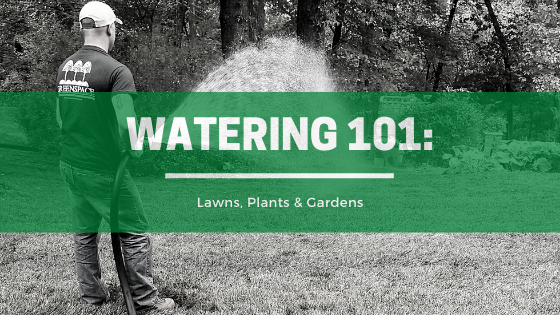Knowing when to water and how-to water is one of the most important aspects of gardening and can make all the difference to the health of plants and your lawn. With hot, dry summer weather prevailing over much of Iowa, rain has been much needed for many homeowners. However we can’t control the weather, only our sprinklers. So how much watering should you be doing?
Is it necessary to water the lawn during hot, dry weather?
Individuals have two basic options when confronted with hot, dry weather. One option is to do nothing and allow the grass to go dormant. The alternative is to water the turfgrass during dry weather to maintain a green, actively growing lawn.
Cool-season grasses, such as Kentucky bluegrass, can survive long periods of dry weather. In dry weather, the shoots of the turfgrass plants stop growing and the plants go dormant. Dormancy is a natural survival mechanism for turfgrass. While the leaves have turned brown and died, the turfgrass roots and crowns remain alive. Generally, Kentucky bluegrass can remain dormant for four to six weeks without suffering significant damage.
The other thing to think about is how old is your turf? If you have 1 to 2-year-old sod or a new seeding from last fall or this spring, Greenspace recommends watering.
How often should I be watering the lawn?
Most lawns in Iowa require 1 to 1½ inches of water per week. When watering the lawn, apply this amount in a single application or possibly two applications three or four days apart. Avoid frequent, light applications of water, which promote shallow rooting and lush growth. Lush, shallow-rooted turfgrass is less drought tolerant. It also is more susceptible to pest problems. To determine the amount of water applied by a sprinkler, place two or three rain gauges within the spray pattern.
NOTE: Keep the grass taller when mowing. When you mow the lawn, set the blade to the highest or second highest setting. Keeping grass about 3 inches long shades the soil better and slows evaporation. Tall grass also grows less quickly and has deeper roots. All of these factors reduce the amount you need to water your lawn.
When is the best time to water the lawn?
Early morning (5 to 9 a.m.) is the best time to water a lawn. A morning application allows the water to soak deeply into the soil with little water lost to evaporation. When watering is completed, the turfgrass foliage dries quickly. Watering at mid-day is less efficient because of rapid evaporation, and strong winds may cause uneven water distribution. Strong, mid-day winds also may carry water onto driveways, sidewalks, or streets, wasting considerable amounts of water. Watering lawns in late afternoon or evening may increase disease problems.
How should be watering a newly seeded lawn?
After seeding, keep the upper 1 inch of soil moist by watering once or twice a day. With adequate moisture and soil temperatures of 55 F or above, most turfgrasses should germinate in 2 to 3 weeks. Grass seedlings are very susceptible to desiccation injury. Continue to water the seedlings once or twice a day. When the turfgrass reaches a height of 1 to 2 inches, gradually reduce the frequency of watering, but water more deeply. A thorough watering once a week should be adequate after the new turf has been mowed 2 or 3 times.
How should I water newly laid sod?
A newly sodded lawn should be watered once or twice a day for the first 7 to 10 days. Apply enough water to moisten the sod and the upper 1 inch of soil. Sod will root to the soil in about 10 days. At this point, gradually reduce the frequency of watering, but water more deeply. After the sod has been mowed 3 or 4 times, a deep watering once a week should be adequate.
How often should I water my existing plants and garden?
The frequency of watering is determined by soil characteristics, weather conditions, type of plant material, and other factors. In general, however, a deep watering once a week in dry weather should be adequate for most fruit, vegetable, and flower gardens. When watering gardens, water slowly and deeply. In fruit, vegetable and flower gardens, drip irrigation systems and soaker hoses are more efficient and cause fewer disease problems than sprinklers.
What about watering newly planted trees & shrubs?
Water is often the most limiting growth requirement for trees and shrubs in the landscape. However, over watering can become an issue as well. If your plant is less than 1 – 2 years old – ideally, watering should begin when this soil region becomes dry and can no longer supply the needed water to the plant. One can also use the “hand” method to determine moisture condition of the soil. Simply feel a handful of soil from a depth of 6-12 inches to determine its moisture level. In Iowa, an average time frame is to water new trees every 7 to 14 days if less than one inch of rainfall is received during the same time period. If it is a brand-new tree or shrub that was planted, Greenspace suggests thoroughly soaking the plant every 2 – 3 days for 4 weeks after installation.
I think that wraps things up for Watering 101. Do you have specific questions about your lawn or landscaping? Contact us today and we would be happy to help!


Pingback: 5 Summer Lawn Care Myths Busted - Greenspace Associates
Pingback: Summer Maintenance Tips For Your Outdoor Space - Greenspace Associates